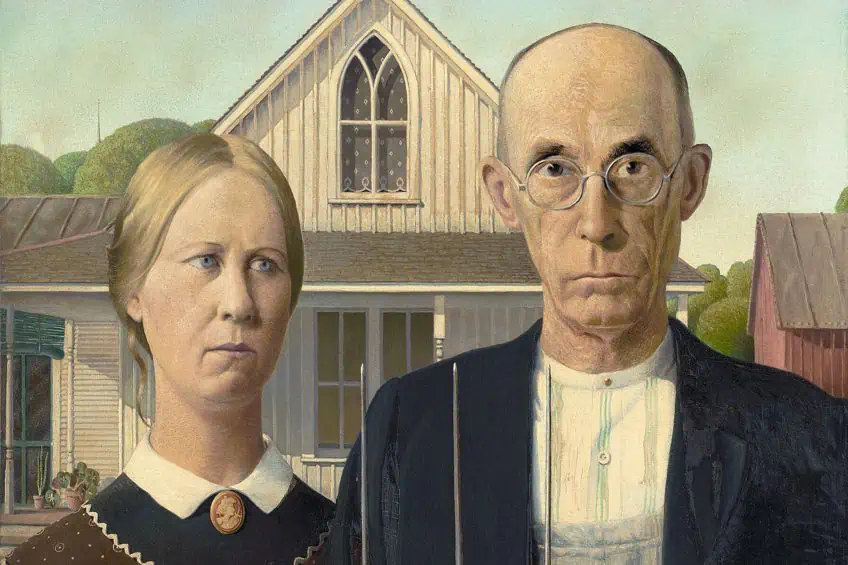Famous American Paintings – Explore the 15 Best Examples
Art from America has produced many global art movements that significantly impacted the reception of new art styles and the fusion of styles from other countries. From early American painters like Mather Brown to great American artists like Mary Cassatt and James McNeill Whistler, the development of painting in America has much to teach us about American identity, society, and cultural development since the colonization of Native peoples. In this article, we will explore a selection of the 15 most famous American paintings in art history. Read on to discover the hidden gems behind some of America’s most talked-about works of art!
The Evolution of Painting in American Art
Today, most understand American art to encompass some of the most revolutionary art movements from the 20th century. From art styles and concepts of the American Southwest to the Harlem Renaissance, Abstract Expressionism, and street art, American artists have boldly expressed their inner worlds, histories, and societies that shaped them. However, the evolution of painting on its own in America is not as clear-cut as most believe it to be.
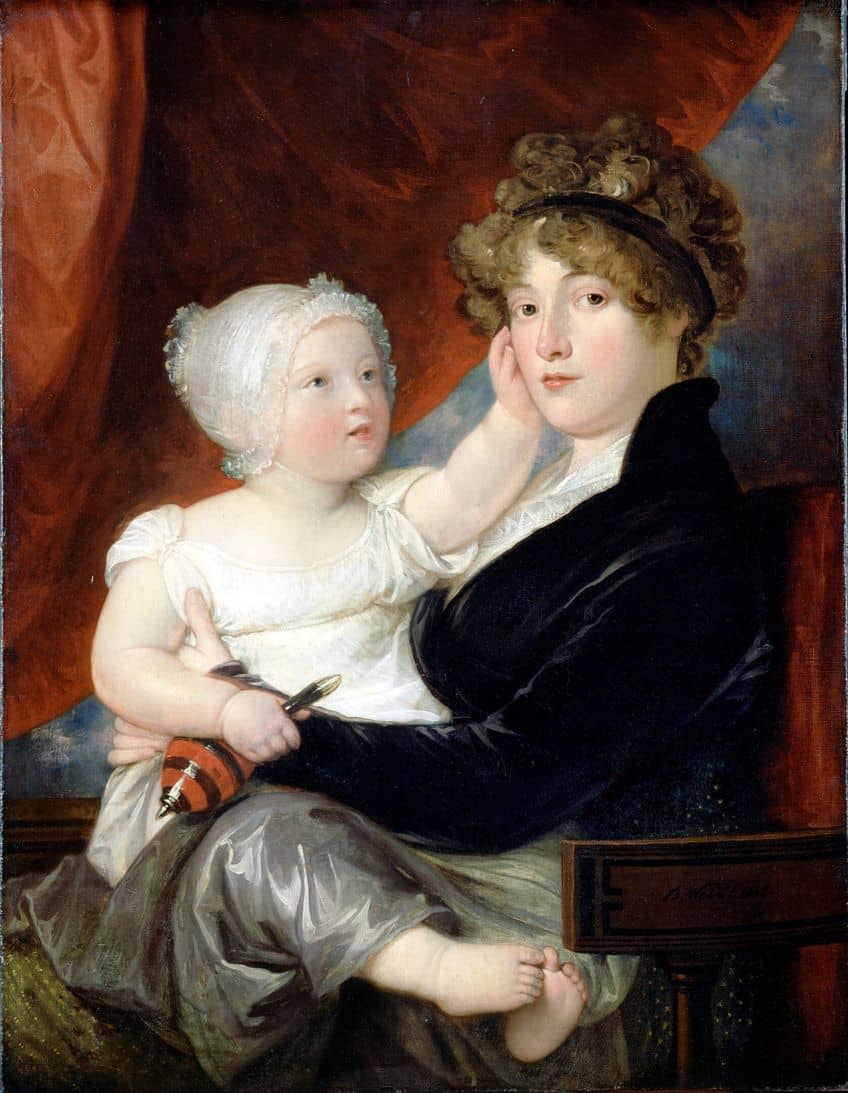
The dawn of American art can be traced back to the art styles of Native American art, of which a few key groups remain today that demonstrate the generations of Native art styles that were passed on from generation to generation after colonization. Colonial influences dominated American art as a new development as early as the 16th century when the East Coast was exposed to European artists such as John White, a colonial governor and artist. Landscape painting styles were mostly influenced by English painting styles while portraiture was one genre that was incredibly popular throughout the 18th and 19th centuries.
Toward the late-18th century, two of the most famous American painters John Singleton Copley and Benjamin West were recognized in London as major contributors to history painting. At the time, history painting was a niche genre of painting that was considered to be the highest form of art. Other American artists often painted from their homes while remaining unrecognized by the global eye and by 1820, the Hudson River School was established to train new artists, resulting in a new wave of Romantic painters.
American nationalism and identity were further grounded in 1776 with the Declaration of Independence, which saw many self-taught artists of the colonial era emulate the styles of art found in British art.
American Revolutionists also inspired artists to explore political portraits of new officials, which gained traction in art and postal stamp designs toward the 19th century. Styles such as Luminism thrived in the 19th century alongside Tonalism and depictions of rural America. African-American painters like Robert S. Duncanson from the Hudson River School are credited with creating some of the most important landscape artworks of the 19th century. Native cultures also appeared in works of painters who took an interest in the Great West while history painting declined in popularity.
City life and the middle class were represented by painters such as Thomas Eakins while states like Philadelphia produced styles like trompe-l’œil. An important point to note is that many late-19th-century and 20th-century painters spent periods in Europe to study the styles of European painters and influenced trends in American Impressionism. Artists like Theodore Robinson were inspired by Claude Monet, who was a pioneer of French Impressionism, and whose style led Robinson to become one of the first American painters to adopt the style.
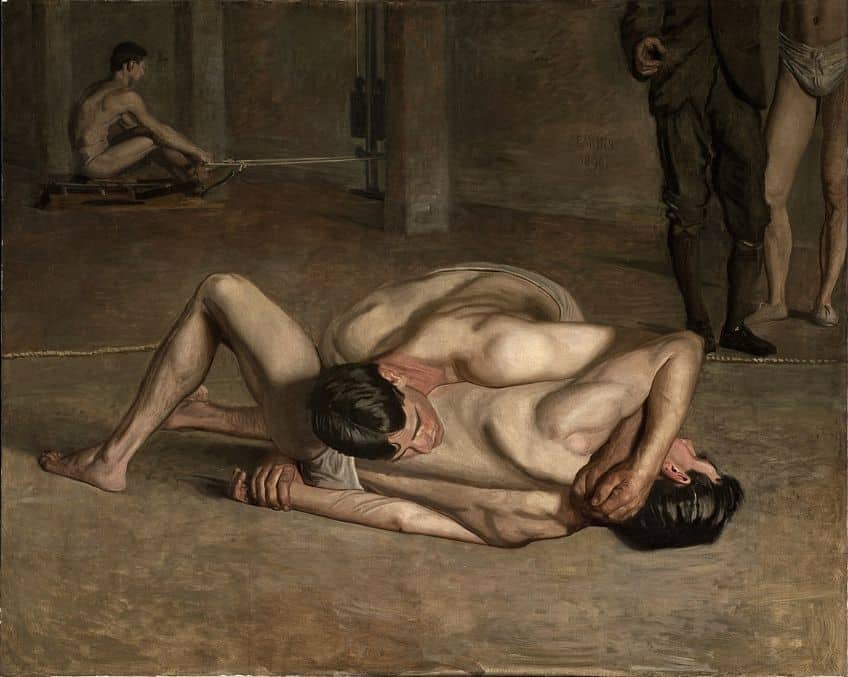
Revolutionary schools such as the Ashcan School of Painting propelled the rejection of traditional painting styles, which sparked American Realism in the early 20th century and many modernist artists. Following the First World War, paintings from America began to reject some of the styles seen in Parisian works exhibited at the Armory show and opted for academic approaches. Influential styles in modernist painting were seen in Precisionism and later critical works produced during the Harlem Renaissance, which broadened the engagement with underrepresented African-American cultures and communities. The Great Depression led to an increase in public art programs and artists influenced by the Mexican Muralism group to produce Social Realism and Regionalism painters.
15 Famous American Paintings You Need to Know
Following the Second World War, movements such as Abstract Expressionism and Neo-Expressionism started to dominate American painting styles. The 20th century produced some of the most riveting art styles, techniques, and movements in painting that have influenced and shaped the minds of the 21st century.
Below, we will examine the 15 most famous American paintings in art history that have contributed significantly to specific art movements, styles, and painting techniques in American painting history.
Paul Revere (1770) by John Singleton Copley
| Artist Name | John Singleton Copley (1738 – 1815) |
| Date | 1770 |
| Medium | Oil on canvas |
| Dimensions (cm) | 89.22 x 72.39 |
| Where It Is Housed | Museum of Fine Arts (MFA), Boston, Massachusetts, United States |
Paul Revere is considered to be one of the most famous portrait paintings from the late 18th century that was created in oil by John Singleton Copley. Copley was a famous American painter, who was recognized in England and America for his Realism painting style and historical subjects.
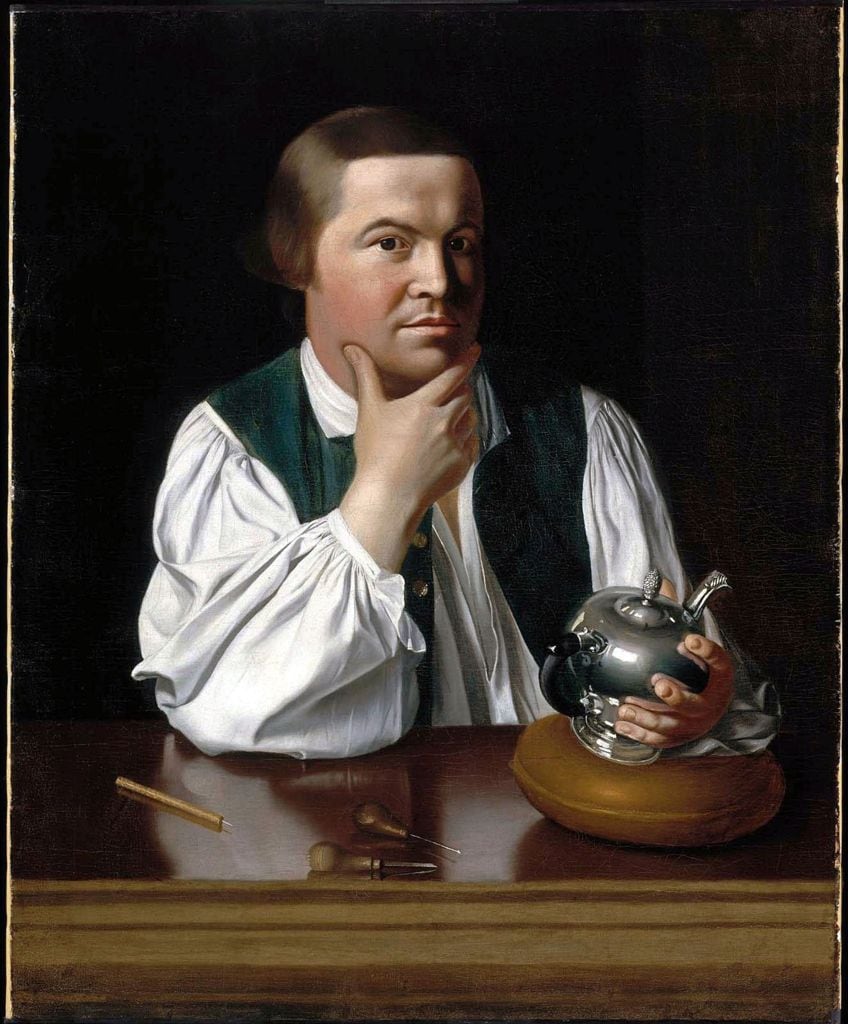
As such, he is recognized in American art history as one of the best American painters of the colonial period. His painting, Paul Revere, is an example of the famous American painter’s only complete portrait of an artisan depicted at his polished table in casual attire while working. One of the amazing aspects of this 18th-century portrait is the many objects that are featured in the work and the rococo style that can be spotted in the depiction of the teapots.
The painting has since remained a symbol of Copley’s career and a key piece of colonial painting, which is currently housed at the Museum of Fine Arts in Boston.
Lansdowne Portrait (1796) by Gilbert Stuart
| Artist Name | Gilbert Charles Stuart (1755 – 1828) |
| Date | 1796 |
| Medium | Oil on canvas |
| Dimensions (cm) | 247.6 x 158.7 |
| Where It Is Housed | National Portrait Gallery, Washington, D.C., United States |
Another famous American painter from the 18th century who produced one of the most iconic American paintings was Gilbert Stuart. Gilbert Stuart created this renowned portrait of George Washington, which has, since its creation, become one of the most popularized and reproduced images in American history.
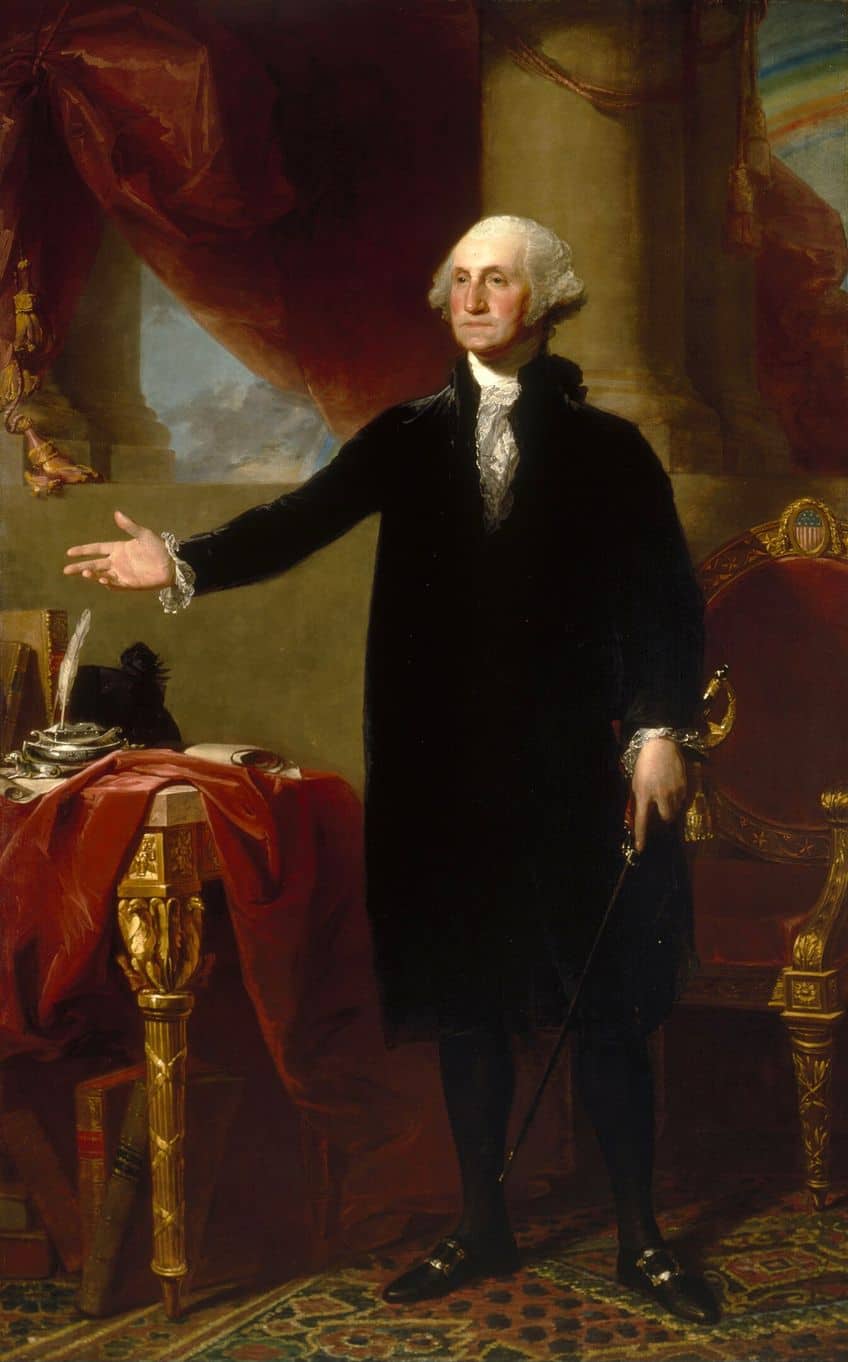
One of the motivations behind Stuart’s pursuit of painting American leaders was to make a profit out of it and boost his career. After Stuart created his first portrait of George Washington, he went on to produce more than 100 copies for many international patrons who were keen to get their hands on a portrait of George Washington. Now recognized as the Lansdowne Portrait, the full-length portrait shows the 64-year-old President in his final year in office and appears dressed in civilian attire. In 2001, the painting was acquired by the National Portrait Gallery for $20 million.
The painting itself was originally named after its owner, the Marquis of Lansdowne.
Whistler’s Mother (1871) by James McNeill Whistler
| Artist Name | James Abbott McNeill Whistler (1834 – 1903) |
| Date | 1871 |
| Medium | Oil on canvas |
| Dimensions (cm) | 144.3 x 162.4 |
| Where It Is Housed | Musée d’Orsay, Paris, France |
Also recognized by its other title Gray and Black No. 1 (1871), this famous American painting was produced by James McNeill Whistler in 1871. The composition references a longstanding tradition in painting depicting women seated.
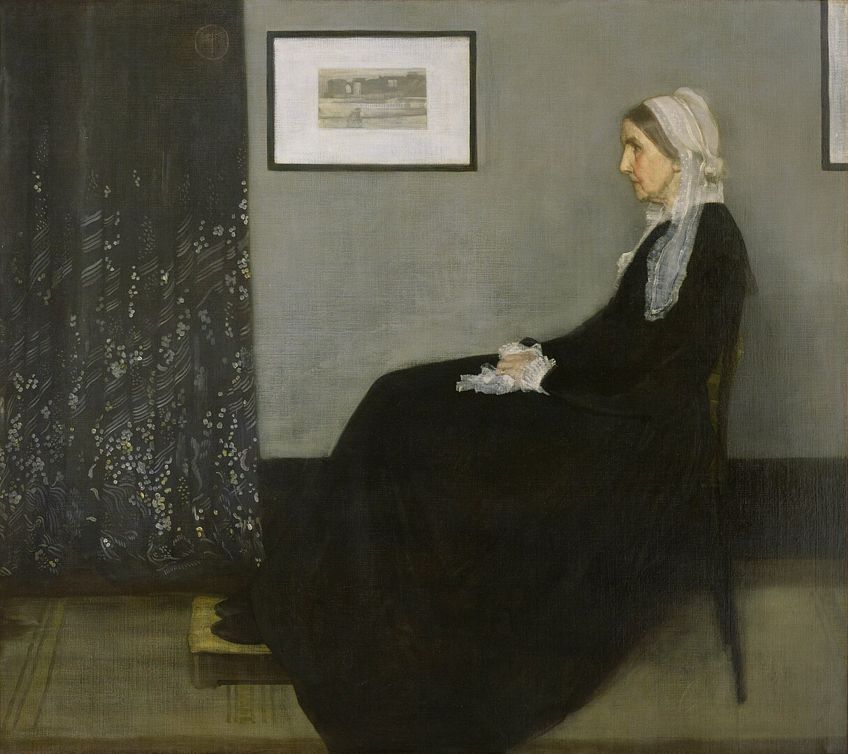
While Whistler himself only spent a few years in America during his childhood and twenties, his work drew on styles from European and Asian paintings. The painting itself was also acquired by the French government as the first American painting to enter the national collection. French critics attributed the gray-toned palette of the work to London’s polluted climate when it was first exhibited in 1883 but was still a bold statement to Victorian viewers at the time. His mother is portrayed in a still and yet grim scene of mourning.
Another interesting point worth noting is that the painting seemed to deeply affect the renowned composer Claude Debussy, who compared his own approach to music to that of Whistler’s exploration of gray tones.
Little Girl in a Blue Armchair (1878) by Mary Cassatt
| Artist Name | Mary Stevenson Cassatt (1844 – 1926) |
| Date | 1878 |
| Medium | Oil on canvas |
| Dimensions (cm) | 89.5 x 129.8 |
| Where It Is Housed | National Gallery of Art, Washington D.C., United States |
Little Girl in a Blue Armchair is one of the most famous paintings of American Impressionism that was inspired by Mary Cassatt’s relationship with the French Impressionists.
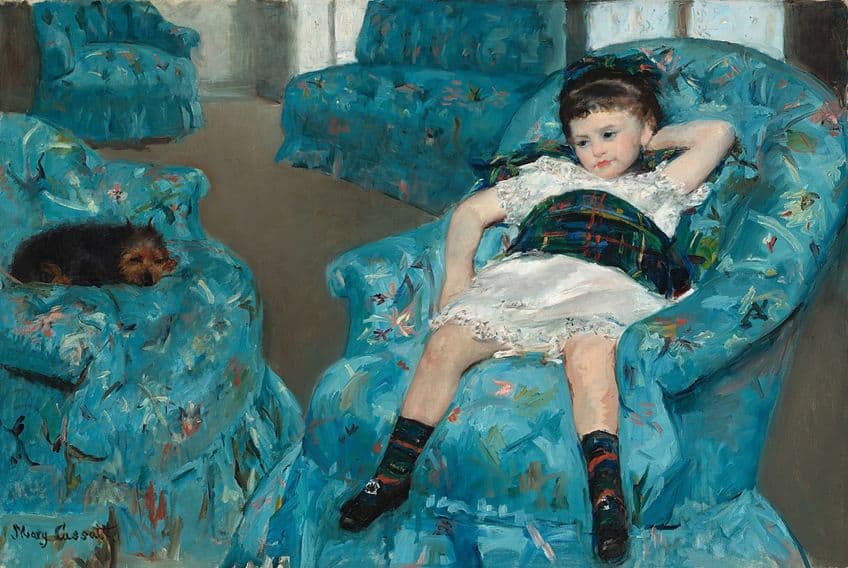
Mary Cassatt frequently visited Europe and drew inspiration from French Impressionist styles, using vibrant brush strokes and a limited color palette. This famous painting is a testament to Cassatt’s exploration of light in a French setting, as seen in the French doors in the background of the painting. Cassatt’s painting is also an example of the dynamics between rest and play, as seen in the contrast created by the little girl who appears flopped on a chair and is accompanied by a small dog.
Cassatt’s vibrant and energetic brushwork also stands in contrast to the relationships between the girl and the dog, as well as the tilted plane of the composition and haphazard placement of the blue chairs.
Portrait of Madame X (1884) by John Singer Sargent
| Artist Name | John Singer Sargent (1856 – 1925) |
| Date | 1884 |
| Medium | Oil on canvas |
| Dimensions (cm) | 234.95 x 109.86 |
| Where It Is Housed | Metropolitan Museum of Art, New York City, United States |
Portrait of Madame X is by far one of the most famous American paintings of the 19th century that also shocked the art world. The model in the portrait was Virginie Amélie Avegno Gautreau, an American expatriate who was renowned in Parisian circles for her social status as the wife of a French banker, as well as rumors surrounding her fidelity and her beauty.
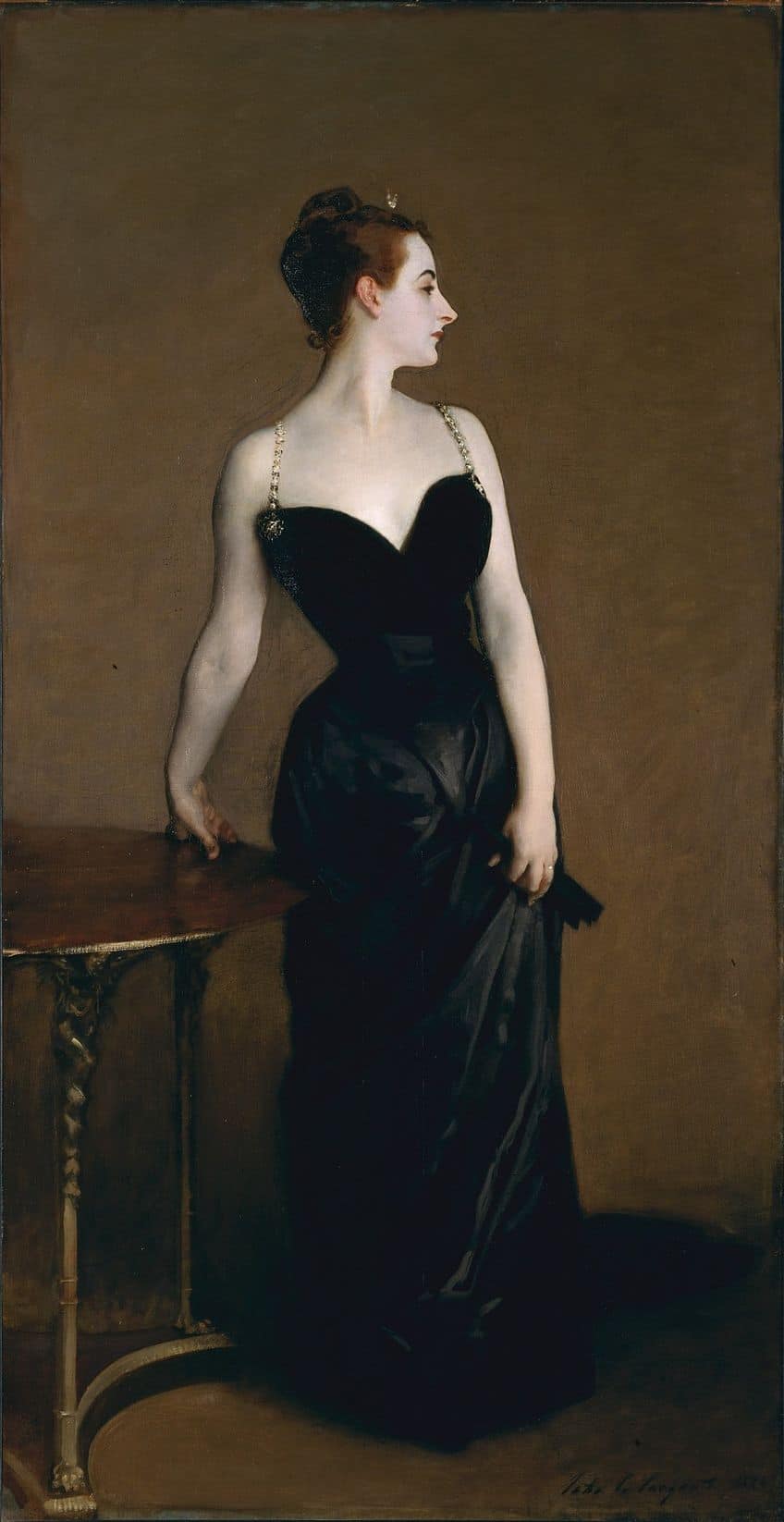
The model was considered to be a professional beauty, which was an English term attributed to someone who used their appearance to empower themselves and advance their social status. The portrait was painted by the esteemed painter John Singer Sargent, who depicted Gautreau in an elegant black dress designed with jeweled straps that highlighted her pale skin. The portrait is known to have revealed and concealed certain elements at once and was considered particularly controversial when it was first exhibited at the Salon in 1884.
It was only later that Sargent received praise in American and English circles for his masterful rendition of the socialite.
Stag at Sharkey’s (1909) by George Bellows
| Artist Name | George Wesley Bellows (1882 – 1925) |
| Date | 1909 |
| Medium | Oil on canvas |
| Dimensions (cm) | 92 x 122.6 |
| Where It Is Housed | Cleveland Museum of Art, Ohio, United States |
Created by George Wesley Bellows in 1909, this famous American painting embodies the teachings of the Ashcan School movement in the early 20th century and depicts two boxers from a private athletic club that was located close to Bellows’ studio.
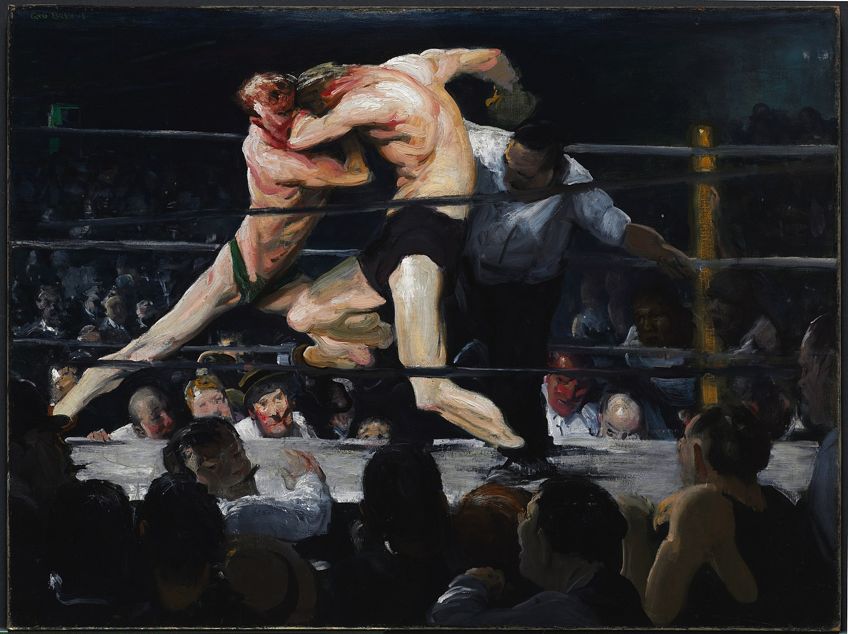
The energy and movement in the painting are remarkable as Bellows rendered the action scene using fast brushstrokes to create a blurry atmosphere. In a statement by the artist, Bellows wished to portray two boxers, whose focus was purely on trying to kill each other.
Stag at Sharkey’s belongs to a series of paintings based on boxing, of which a copy of the scene was reproduced as a lithograph in 1917.
American Gothic (1930) by Grant Wood
| Artist Name | Grant DeVolson Wood (1891 – 1942) |
| Date | 1930 |
| Medium | Oil on beaverboard |
| Dimensions (cm) | 74 x 62 |
| Where It Is Housed | School of the Art Institute of Chicago, Illinois, United States |
This is perhaps one of the most famous paintings of American Regionalism that is instantly recognizable by most art enthusiasts. American Gothic is the embodiment of American Regionalism painting, which thrived briefly in the early 20th century.
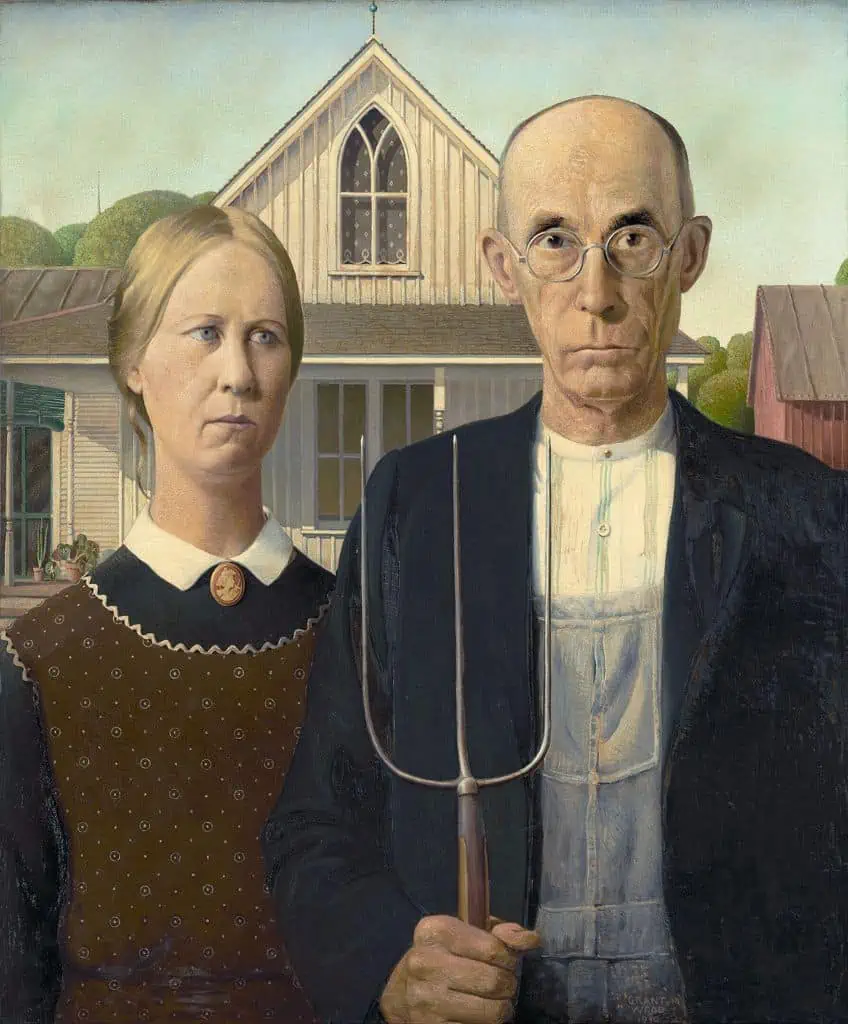
The work portrays a father and daughter, who are standing outside of their traditional American Midwest home. The painting captured the American spirit of the time, which was driven by Social Realism in painting and themes of farming and agriculture as key themes in rural American life.
The American artist Grant Wood specialized in scenes of rural America, including the Iowa cornfields and mythical subjects from American history.
Nighthawks (1942) by Edward Hopper
| Artist Name | Edward Hopper (1882 – 1967) |
| Date | 1942 |
| Medium | Oil on canvas |
| Dimensions (cm) | 84.1 x 152.4 |
| Where It Is Housed | Art Institute of Chicago, Illinois, United States |
Nighthawks offers insight into the Social Realist urban landscape, which was inspired by Edward Hopper’s passion for philosophy and film.
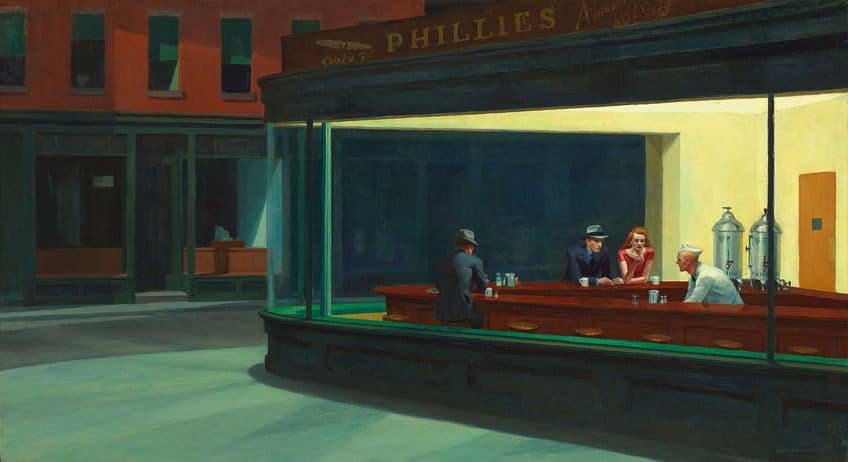
The scene is recognized as Hopper’s most famous artwork and was perhaps motivated by The Killers (1927) by Ernest Hemingway. The scene is said to portray the loneliness of a large city and was received well by many painters and sculptors alike who used the image as a source of inspiration.
Within months of the painting’s release, it was sold for $3000 to the Art Institute of Chicago, where it currently remains.
Freedom From Want (1943) by Norman Rockwell
| Artist Name | Norman Percevel Rockwell (1894 – 1978) |
| Date | 1943 |
| Medium | Oil on canvas |
| Dimensions (cm) | 116.2 × 90 |
| Where It Is Housed | Norman Rockwell Museum, Massachusetts, United States |
Freedom From Want is a renowned series of Thanksgiving-themed paintings created by famous American painter Norman Rockwell in 1943.
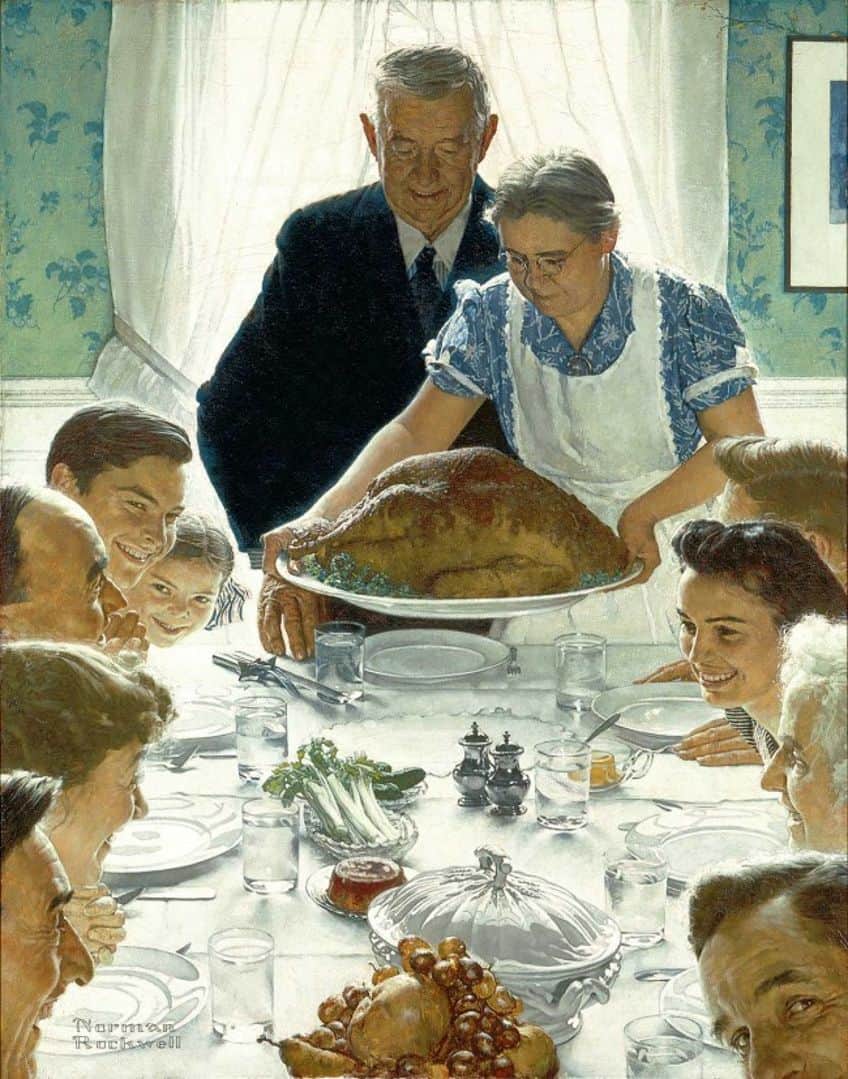
The painting is also recognized as I’ll Be Home for Christmas or The Thanksgiving Picture, which was inspired by the 1941 State of the Union Address by Franklin D. Roosevelt. The painting was created as an illustration for The Saturday Evening Post and has since become one of the best American paintings.
It symbolizes the will for global economic understanding that will enable all nations to enjoy peace for all their inhabitants across the world.
No. 5 (1948) by Jackson Pollock
| Artist Name | Paul Jackson Pollock (1912 – 1956) |
| Date | 1948 |
| Medium | Oil on fiberboard |
| Dimensions (cm) | 240 x 120 |
| Where It Is Housed | Private collection, New York City, United States |
No. 5 by Jackson Pollock is a famous American painting that is worth well over $140 million. The abstract composition embodies the 20th-century art movement and style rooted in Abstract Expressionism and created using the modern technique known as action painting.
Pollock, who was one of the greatest American painters, created the large painting using liquid and synthetic resin paints to create the chaotic nest of colors. The work was also later reconstructed and reworked by Pollock to draw attention to more linear relationships in the painting, which reinforced the metaphysical concept behind the painting.
Over time, the work was referenced in many productions of popular culture, including Alex Garland’s Ex Machina (2015) and a song by The Stone Roses titled Going Down.
Christina’s World (1948) by Andrew Wyeth
| Artist Name | Andrew Newell Wyeth (1917 – 2009) |
| Date | 1948 |
| Medium | Tempera and gesso on panel |
| Dimensions (cm) | 82 x 121 |
| Where It Is Housed | The Museum of Modern Art, New York City, United States |
This famous 1948 masterpiece is a renowned prairie scene and portrait of a young lady, who is lying in the middle of a field gazing toward a remote house on a hill ahead of her. The famous American artwork was created by Andrew Wyeth and is unique for many reasons since the painting is not just a landscape but a reflection of a bleak and inescapable society.
The context of the painting follows Wyeth’s memory of his neighbor, who was a young girl suffering from polio, which left her physically impaired and unable to walk. What makes the work emotionally impactful is the solitary nature of the young girl who appears to be abandoned in a field with seemingly no way for her to get home. An additional point on Wyeth’s account worth noting is the strength of the young girl, whom Wyeth recalled as refusing to use a wheelchair.
Instead, she dragged herself to where she needed to be using only her arms.
Campbell’s Soup Cans (1961 – 1962) by Andy Warhol
| Artist Name | Andy Warhol (1928 – 1987) |
| Date | 1961 – 1962 |
| Medium | Acrylic with metallic enamel paint on canvas |
| Dimensions (cm) | 50.8 x 40.6 |
| Where It Is Housed | The Museum of Modern Art, New York City, United States |
Andy Warhol was perhaps one of the most famous American painters of the 1960s, whose silkscreen portraits of celebrities and models influenced the styles of Pop art in the 20th century.
His artwork, Campbell’s Soup Cans, was released between 1961 and 1962 and is recognized as one of the greatest American paintings of the decade that represents the elevation of everyday commercial products into the realm of fine art. When questioned about the work, Warhol pointed out the inspiration for it emerged from his routine and meal, which he ate for the past 20 years, and culminated in a series of 32 identical paintings.
The work also emphasized the idea that painting is a site for originality and innovation.
Marilyn Diptych (1962) by Andy Warhol
| Artist Name | Andy Warhol (1928 – 1987) |
| Date | 1962 |
| Medium | Silkscreen ink and acrylic paint on canvas |
| Dimensions (cm) | 205.44 x 289.56 |
| Where It Is Housed | Tate, London, United Kingdom |
The Marilyn Diptych is one of the best American paintings created by one of the country’s greatest American painters, Andy Warhol in 1962.
The painting was produced not long after the Hollywood actress’ death and incorporated the portrait of Marilyn Monroe that was featured in her film Niagara in 1953. What adds more depth to the portraits is the notion that the work was modeled similarly to that of Christian diptychs, which were often created on two framed panels.
These elevated Monroe’s status as more than an icon, but an almost religious icon of American pop culture.
Whaam! (1963) by Roy Lichtenstein
| Artist Name | Roy Lichtenstein (1923–1997) |
| Date | 1963 |
| Medium | Acrylic and oil on canvas |
| Dimensions (cm) | 172.7 x 406.4 |
| Where It Is Housed | Tate, London, United Kingdom |
Pop art of the 1960s is perhaps one of the most culturally significant art movements that emphasized the role of popular culture and its mass consumption as a key characteristic of contemporary art practice.
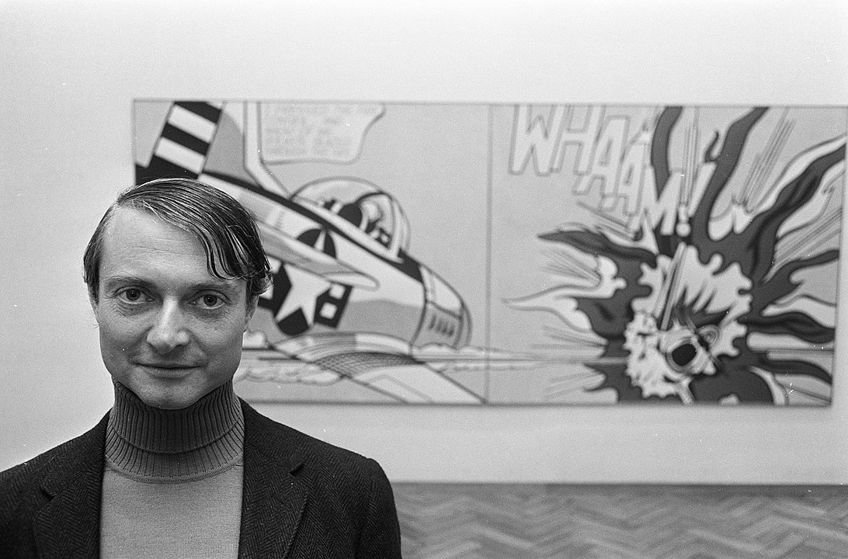
Whaam! is one such American painting that embodied the playful comic book style of the time with bold outlines, onomatopoeic text, and primary colors composed by Roy Lichtenstein in 1963. The work was inspired by the work of Irv Novick, who published an illustrated panel in the DC comic All-American Men of War in 1962. Lichtenstein appropriated the image and made a few alterations to its color and selection of scenes he wished to portray.
Lichtenstein himself stated that his work, which involved appropriation, was more of an act of transformation involving images from cartoons and advertising.
Untitled (1982) by Jean-Michel Basquiat
| Artist Name | Jean-Michel Basquiat (1960 – 1988) |
| Date | 1982 |
| Medium | Acrylic, spray paint, and oil stick on canvas |
| Dimensions (cm) | 183.2 x 173 |
| Where It Is Housed | Collection of Yusaku Maezawa |
Jean-Michel Basquiat was an iconic American painter of the late-modern period, whose rise to fame in New York City is admired by many Contemporary painters. Basquiat’s unique compositions were inspired by graffiti art and his personal journey as an artist, who unfortunately lost his life too young. Untitled is a famous American painting that was purchased in 2017 by the Japanese mogul Yusaku Maezawa for $110.5 million. The composition includes an animated skull set against a brilliant blue backdrop surrounded by fragments of Basquiat’s view of the Brooklyn area, which he lived in during his early adult years. The painting encompasses the American “big city life” accompanied by the unpredictability of such American cities that made it a memorable experience.
These inspirational and unforgettable American paintings have circulated the global art scene for decades, and continue to be remembered for their place in American art history. We hope that you have enjoyed reviewing the top 15 famous American artworks that provide insight into the history and cultural development of the last three centuries.
Frequently Asked Questions
What Is the Most Famous American Painting?
American Gothic (1930) is regarded as the most famous American painting of the 20th century, and is widely recognized as the most identifiable American artwork. The painting was created by Grant Wood and is a symbol of American Regionalism.
Who Are the Three Greatest American Painters?
The top three greatest American painters include artists from different centuries and art movements. These artists include Benjamin West, Gilbert Stuart, and Jean-Michel Basquiat, of whom only cover a speck of great American artists who contributed to American art history and painting.
What Is the Most Expensive American Painting?
Shot Sage Blue Marilyn (1964) by Andy Warhol is regarded as the most expensive American painting to date. The painting depicts the portrait of Marilyn Monroe and sold for $195 million in 2022 at Christie’s in New York.
Jordan Anthony is a Cape Town-based film photographer, curator, and arts writer. She holds a Bachelor of Art in Fine Arts from the University of the Witwatersrand, Johannesburg, where she explored themes like healing, identity, dreams, and intuitive creation in her Contemporary art practice. Jordan has collaborated with various local art institutions, including the KZNSA Gallery in Durban, the Turbine Art Fair, and the Wits Art Museum. Her photography focuses on abstract color manipulations, portraiture, candid shots, and urban landscapes. She’s intrigued by philosophy, memory, and esotericism, drawing inspiration from Surrealism, Fluxus, and ancient civilizations, as well as childhood influences and found objects. Jordan is working for artfilemagazine since 2022 and writes blog posts about art history and photography.
Learn more about Jordan Anthony and about us.
Cite this Article
Jordan, Anthony, “Famous American Paintings – Explore the 15 Best Examples.” artfilemagazine – Your Online Art Source. November 1, 2023. URL: https://artfilemagazine.com/famous-american-paintings/
Anthony, J. (2023, 1 November). Famous American Paintings – Explore the 15 Best Examples. artfilemagazine – Your Online Art Source. https://artfilemagazine.com/famous-american-paintings/
Anthony, Jordan. “Famous American Paintings – Explore the 15 Best Examples.” artfilemagazine – Your Online Art Source, November 1, 2023. https://artfilemagazine.com/famous-american-paintings/.


